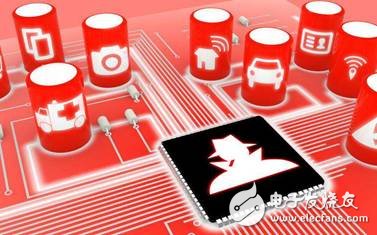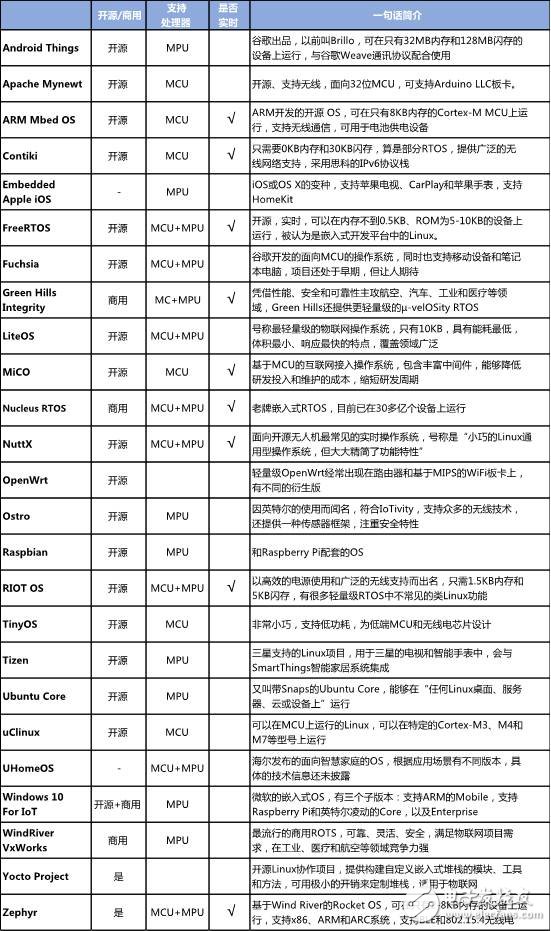Every great era needs a great operating system (OS), which seems to be the iron law of the technology circle. Windows has Windows, mobile era is iOS and Android Qifei, who is the king of the Internet of Things era? Looking around, we will find that there are too many OSs to be king! This is a long list. Although there are heroes who don't ask the source, we are still curious about where these IoT OSs come from. To sum up, their origins fall into four categories: First, traditional OS giants such as Microsoft, Google, and Apple , which expand into the Internet of Things; second, the original embedded OS players , such as WindRiver and Green Hills, used to be silently in vertical markets work, and now finally found an opportunity to do their own thing to stand under the spotlight; the third is the contribution of many geeks in the open source community, things for the results of their work to provide more opportunities for landing; four Some manufacturers who are "not doing business" , take Malay to join in the fun, such as ARM for processor core, Qingke for WiFi module, Huawei, Haier for terminal products, etc. "When the value chain of the Internet of Things industry is not stable, Rely on the OS card position, when it is their subtext. The fragmentation of the Internet of Things is destined to be difficult to be dominated by an OS. This provides a growing soil for the Internet of Things OS. Everyone competes to avoid weaknesses and establish a solid foundation in the niche market. However, although these IoT OSs have different forms, they are surprisingly consistent in terms of product design. such as: Lightweight, can be tailored: Everyone is claiming that their size is small, the amount of food is small (less resources are used), and it is in line with the tonality of the Internet of Things. OS developers will also tailor the OS to different versions based on the differences in the application scenarios to meet the tastes of the target users. Security: This is almost the standard for the Internet of Things OS. The commercial version is always a selling point, allowing users to pay for it with willingness. After all, a BUG in the digital world may be a disaster in the physical world, sloppy. Connectivity: No need to explain more, IoT OS is embarrassed to go out if it does not support wireless connectivity. Supporting resources: In fact, many IoT OSs are not limited to the OS itself. The rich software resources such as protocol stacks and middleware can make users more worry-free. So to do the OS, go ahead, it becomes an ecological, and accidentally play big. Or, to put it another way, companies with more robust ecosystems are more likely to be on the Internet of Things OS. Even with the above commonalities, it is not an easy task for users to make choices in dozens of OSs. Since the OS has been tailored by their developers, there is a lack of a uniform ruler if it is compared from a software function. The most feasible way to do this is to start from the final application and follow the "needs". There are a few basic elements to consider: The first is cost . Thanks to Internet thinking, there are more and more open-source Internet of Things OS, and there are also feelings of "do not make money, do things first" (of course, there may be support from various gold owners). Some commercial OS companies are also testing open source, semi-open source strategies, or actively participating in open source OS projects. This greatly reduces the acquisition cost of the Internet of Things OS. However, from the perspective of later use costs, it is necessary to consider the convenience of OS development tools and resources, as well as the ability to support services continuously. After all, taking the OS as a geek project and playing a commercial IoT product are two concepts. Followed by the supported hardware . Although they all claim to be "lightweight," there is still a big difference in the hardware operating environment between the Internet of Things OS. We can roughly classify them into two categories: running on a powerful microprocessor MPU (such as x86, ARM Cortex-A architecture), using more resources, and supporting microcontroller MCUs (such as ARM). Cortex-M architecture), a lighter little guy. The former is often the advantage of traditional OS vendors; the latter's market competition is getting stronger, because it is conceivable that future MCU-based IoT devices will be massive. There will also be OSs that can "take all" two types of hardware environments. The final choice depends on the application scenario of the final product. The third is real-time . Some IoT applications will emphasize real-time performance, which requires the selection of real-time operating system RTOS. This type of OS can realize multi-tasking, scheduling and prioritizing tasks, sharing resources between multiple tasks, and of course the system is more complicated. If there is no real-time consideration, there are OSs with lower power consumption and fewer resource requirements to choose from. Such OS is also a hot spot for recent market growth. Said a lot, finally on the list! This is the OS that we are currently able to observe in the market and claim to be the goal of the material network. In the end, the market reshuffle after the competition is inevitable, but since they have come, they should pay attention and respect every effort. Wireless Power Bank,Fast Charge Power Bank,Usb Battery Pack,10000mah Power Bank Pogo Technology International Ltd , https://www.wisesir.net


November 19, 2022